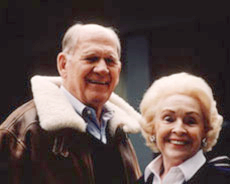
Trammell Crow
Fred Trammell Crow (June 10, 1914 – January 14, 2009) was an American real estate developer from Dallas, Texas. He is credited with the creation of several major real estate projects, including the Dallas Market Center, Peachtree Center in Atlanta, Georgia, and the Embarcadero Center in San Francisco, California.[1]
Trammell Crow
Real estate developer; Art collector
Biography[edit]
A native of Dallas, Crow earned money through a series of odd jobs as a child and later as an adolescent, including plucking chickens, cleaning bricks, and unloading boxcars. He was the fifth of eight children reared in East Dallas. His father, Jefferson Crow, worked as a bookkeeper for Collett Munger, one of Dallas' early real estate developers and the builder of the Munger Place subdivision.
Crow graduated from Woodrow Wilson High School in 1932. Unable to attend college because of the Great Depression, he worked at several odd jobs. In 1933, Crow landed a job for roughly $13 a week (equivalent to $305.98 in 2023) as a runner for Mercantile National Bank in Dallas while attending night school in accounting at Southern Methodist University. Upon graduation in 1938, he was, at the age of twenty-four, the youngest CPA in Texas.[2]
He then worked for three years as a Certified Public Accountant before joining the United States Navy in 1940. He used his background in accounting and was offered a commission auditing the books of defense contractors. After World War II, he remained with the Navy for another year to handle final settlements with its contractors. He left the Navy after achieving the rank of commander and then returned to Dallas and saw opportunities for the growth of the city.[2]
He became an agent for North American Van Lines, a moving company. Shortly thereafter, he worked as a wholesale grain merchandiser, tripled the sizes of the warehouses, and erected new loading facilities. Once the grain business faded, he switched at the age of thirty-three to the burgeoning field of warehouse real estate development.[2]
Crow built his first warehouse in 1948 and leased it to Ray-O-Vac Battery Company. The warehouse was larger than what Ray-O-Vac needed, and Crow was able to seek additional tenants. He convinced Decca Records to sign for the leftover space, and began a career as a "speculative builder." This field was a new concept in property development, one in which builders typically designed construction to meet the expressed needs of one specific company, then leased the entire space to that company after the building was in place.
He continued from his start with a single-story warehouse on the banks of the Trinity River in the late 1940s. In partnerships with John M. Stemmons, he became one of the largest developers in the Trinity River Industrial Park. By the middle 1950s, Crow was Dallas' largest warehouse builder.
His company's skyscrapers – including Dallas' 50-story Trammell Crow Center and the 53-story Chase Tower – reshaped skylines in the 1980s in cities stretching from Charlotte, North Carolina to San Diego, California.
Art collection[edit]
Trammell Crow was an enthusiastic collector of East Asian art. His son, Trammell S. Crow, went to Yale University with Alex Kerr, and sometime later, after Kerr was more established, he became an art purchaser in Tokyo for the Trammell Crow Company at the behest of his father.[6] In 1998, 598 of the family's best pieces were donated to the people of Dallas with the founding of the Trammell & Margaret Crow Collection of Asian Art.
He also commissioned several pieces from artist Bjørn Wiinblad, also sculptor David Cargill, incorporating them into his Dallas hotel and real estate projects.[7]
Awards[edit]
Crow was awarded the H. Neil Mallon Award by the World Affairs Council in 1986. The H. Neil Mallon Award, hosted by the World Affair Council of Dallas/ Fort Worth, is presented annually to individuals who have excelled at promoting the international focus of North Texas. The prestigious Mallon Award is named after the Council’s founder and is presented annually to individuals who have excelled in promoting our region’s international profile. Funds raised from this event support the World Affair Council’s public and education programming, international exchanges, and diplomatic services.